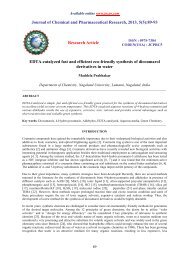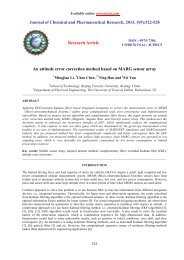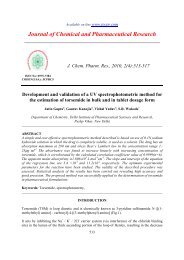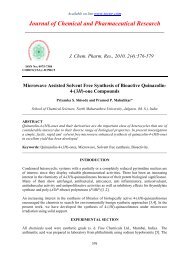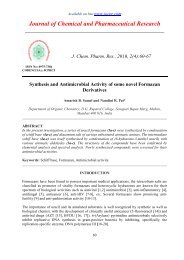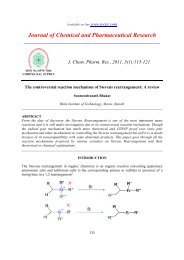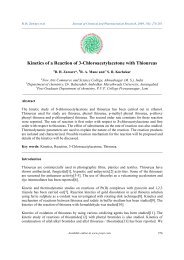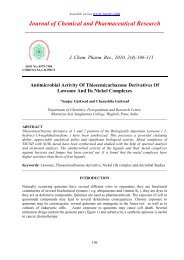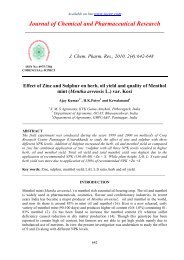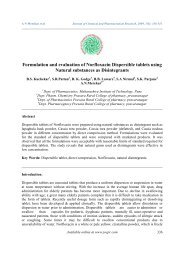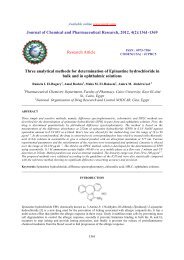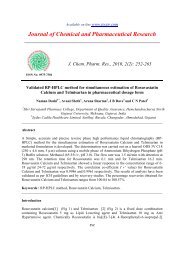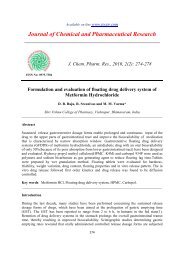Analysis of heavy metals in citrus juice from the Abura-Asebu
Analysis of heavy metals in citrus juice from the Abura-Asebu
Analysis of heavy metals in citrus juice from the Abura-Asebu
Create successful ePaper yourself
Turn your PDF publications into a flip-book with our unique Google optimized e-Paper software.
Available on l<strong>in</strong>e www.jocpr.comJournal <strong>of</strong> Chemical and Pharmaceutical Research__________________________________________________ISSN No: 0975-7384CODEN(USA): JCPRC5J. Chem. Pharm. Res., 2011, 3(2):397-402<strong>Analysis</strong> <strong>of</strong> <strong>heavy</strong> <strong>metals</strong> <strong>in</strong> <strong>citrus</strong> <strong>juice</strong> <strong>from</strong> <strong>the</strong> <strong>Abura</strong>-<strong>Asebu</strong>-Kwamankese District, GhanaJ. K Tufuor *, J. K. Bentum, D.K. Essumang, J. E. Koranteng -AddoDepartment <strong>of</strong> Chemistry University <strong>of</strong> Cape Coast, Cape Coast, Ghana______________________________________________________________________________ABSTRACTThe levels <strong>of</strong> some <strong>heavy</strong> <strong>metals</strong> <strong>in</strong> lime, lemon and orange fruit <strong>juice</strong> <strong>from</strong> <strong>the</strong> <strong>Abura</strong>-<strong>Asebu</strong>-Kwamankese District <strong>of</strong> <strong>the</strong> Central Region <strong>of</strong> Ghana were determ<strong>in</strong>ed. Samples were randomlycollected <strong>from</strong> selected farms <strong>in</strong> <strong>the</strong> district. The samples were digested with HCl and HNO 3mixture (aqua regia) and H 2 O 2 and analysed for AS, Pb, Cr, Ni, Fe, Zn and Cu us<strong>in</strong>g InductiveCoupled Plasma (ICP) Atomic Emission Spectrophotometer. Fe, Zn, and Pb were found <strong>in</strong> all<strong>the</strong> samples with mean concentrations respectively 1.2065, 2.401×10 -1 and 2.92×10 -2 ppm. Cuand As were found <strong>in</strong> <strong>the</strong> lime only with concentrations 4.313×10 -3 and 1.092×10 -3 ppmrespectively. Cr and Ni were not detected <strong>in</strong> any <strong>of</strong> <strong>the</strong> samples analysed. The concentrations <strong>of</strong><strong>the</strong> <strong>metals</strong> found <strong>in</strong> all <strong>the</strong> three fruits were far lower than those Dietary reference values forfood energy and nutrients levels recommended <strong>in</strong> <strong>the</strong> United K<strong>in</strong>gdom and by <strong>the</strong> US EPA.Key Words: <strong>Abura</strong>-<strong>Asebu</strong>-Kwamankese District, <strong>heavy</strong> <strong>metals</strong>, chromium, nickel, arsenic, z<strong>in</strong>c,cupper, lead, iron, orange, lemon and lime.______________________________________________________________________________INTRODUCTIONHeavy metal contam<strong>in</strong>ation <strong>of</strong> fruits, vegetables and o<strong>the</strong>r crops are a major concern s<strong>in</strong>ce <strong>the</strong>iraccumulation <strong>in</strong> food crops <strong>in</strong> higher concentrations could cause serious risk to human health if<strong>the</strong> crops are consumed [1, 2]. Such accumulation has been reported by Okoronko [3]. Arsenic,lead, z<strong>in</strong>c and o<strong>the</strong>r <strong>metals</strong> have been detected <strong>in</strong> food crops at levels that exceed <strong>the</strong>recommended dietary allowance. Although many <strong>heavy</strong> <strong>metals</strong> do not play any significant role <strong>in</strong><strong>the</strong> body <strong>of</strong> plants, <strong>metals</strong> like copper, z<strong>in</strong>c and iron are essential elements <strong>in</strong> <strong>the</strong> body <strong>of</strong> <strong>the</strong>397
J. K Tufuor et al J. Chem. Pharm. Res., 2011, 3(2):397-402______________________________________________________________________________plant due to <strong>the</strong>ir physiological functions. The essential elements are very important because <strong>the</strong>yare <strong>in</strong>volved <strong>in</strong> many enzymes systems <strong>in</strong> <strong>the</strong> human body. However, high concentrations aretoxic [4].The sources <strong>of</strong> <strong>the</strong>se <strong>metals</strong> <strong>in</strong> food crops <strong>in</strong>clude discharges onto agricultural lands, wastewater<strong>from</strong> <strong>in</strong>dustries and sewage, application <strong>of</strong> some pesticides, metal aerosol deposition <strong>from</strong> <strong>the</strong>atmosphere due to emissions <strong>from</strong> vehicles and o<strong>the</strong>r sources. These trace <strong>metals</strong> are alsotranslocated <strong>from</strong> <strong>the</strong> soil solution through <strong>the</strong> roots to o<strong>the</strong>r parts <strong>of</strong> <strong>the</strong> plant [5-7]. Cultivation<strong>of</strong> Citrus crops is a major source <strong>of</strong> <strong>in</strong>come for many farmers <strong>in</strong> <strong>the</strong> district. Also <strong>the</strong> lead<strong>in</strong>gexporter <strong>of</strong> lime <strong>juice</strong> <strong>in</strong> Ghana and some <strong>citrus</strong> process<strong>in</strong>g factories obta<strong>in</strong> <strong>the</strong>ir raw materials<strong>from</strong> <strong>the</strong> district. Accumulation <strong>of</strong> <strong>the</strong>se <strong>heavy</strong> <strong>metals</strong> <strong>in</strong> <strong>the</strong> crops <strong>in</strong> higher concentrationscould cause serious risk to human health if <strong>the</strong> crops are consumed and also adversely affectexport. The objective <strong>of</strong> <strong>the</strong> study <strong>the</strong>refore was to:• Determ<strong>in</strong>e <strong>the</strong> levels <strong>of</strong> As, Pb, Cr, Ni, Cu, Zn and Fe <strong>in</strong> orange, lime and lemon fruits grown<strong>in</strong> <strong>the</strong> <strong>Abura</strong>-<strong>Asebu</strong>-Kwamankese District <strong>in</strong> Ghana.• Compare <strong>the</strong> concentrations <strong>of</strong> <strong>the</strong> various <strong>metals</strong> determ<strong>in</strong>ed <strong>in</strong> this study with recommendeddietary reference values for food energy and nutrients levels <strong>in</strong> o<strong>the</strong>r countries.EXPERIMENTAL SECTIONSample collectionOranges, limes and lemons samples were collected randomly <strong>from</strong> different farms, <strong>in</strong> <strong>the</strong> <strong>Abura</strong>-<strong>Asebu</strong> –kwamankese District <strong>of</strong> <strong>the</strong> Central Region <strong>of</strong> Ghana, and placed <strong>in</strong>to appropriatelylabelled sacks and conveyed to <strong>the</strong> laboratory for analysis. For each <strong>citrus</strong> variety, four sampleswere obta<strong>in</strong>ed for each variety.Sample treatmentThe fruits were washed with tap water and <strong>the</strong>n with distilled water after which <strong>the</strong> <strong>juice</strong> weresqueezed <strong>in</strong>to separate beakers. About 200 mL <strong>of</strong> <strong>juice</strong> was obta<strong>in</strong>ed <strong>from</strong> each sample. The<strong>juice</strong> were filtered, mixed well and <strong>the</strong>n stored <strong>in</strong> a refrigerator prior to analysis. 50 mL <strong>of</strong>sample was placed <strong>in</strong>to a 250 mL beaker. 50 mL <strong>of</strong> aqua regia prepared <strong>from</strong> analytical gradeconcentrated 36% HCl and concentrated 63% HNO 3 was added. The mixture was covered with awatch glass, heated and reflux on a hot plate. Additional 10 mL <strong>of</strong> <strong>the</strong> aqua regia was added and<strong>the</strong> heat<strong>in</strong>g cont<strong>in</strong>ued until <strong>the</strong> colour was very light yellow. The last step was repeated and <strong>the</strong>solution evaporated until <strong>the</strong> volume was about 15-20 mL. The solution was cooled and 10 mL<strong>of</strong> 30% H 2 O 2 (AR) added and heated without boil<strong>in</strong>g until effervescence was m<strong>in</strong>imal to ensurecomplete digestion. The heat<strong>in</strong>g was cont<strong>in</strong>ued and <strong>the</strong> volume reduced to about 10 mL. Thebeaker was removed <strong>from</strong> <strong>the</strong> hot plate cooled and <strong>the</strong> walls washed down with double distilled.The digest was filtered us<strong>in</strong>g Whatman No. 4 filter paper <strong>in</strong>to a 50 mL volumetric flask and <strong>the</strong>ndiluted with double distilled water to <strong>the</strong> 50 mL mark. Four samples each <strong>of</strong> <strong>the</strong> <strong>juice</strong> <strong>from</strong>orange, lemon and lime, and also <strong>the</strong> spiked samples and blank were digested us<strong>in</strong>g this method.All <strong>the</strong> digested samples were analysed for As, Pb, Cr, Ni, Fe, Cu and Zn us<strong>in</strong>g InductiveCoupled Plasma Atomic Emission Spectrometer (ICP).398
J. K Tufuor et al J. Chem. Pharm. Res., 2011, 3(2):397-402______________________________________________________________________________Recovery and Reproducibility StudiesTo validate <strong>the</strong> method <strong>of</strong> analysis, <strong>the</strong> precision <strong>of</strong> <strong>the</strong> <strong>in</strong>strument used and <strong>the</strong> efficiency <strong>of</strong> <strong>the</strong>method used <strong>in</strong> <strong>the</strong> chemical analysis were determ<strong>in</strong>ed. The recovery and reproducibility studieswere conducted us<strong>in</strong>g standards <strong>of</strong> known concentrations. In <strong>the</strong> reproducibility studies, knowncertified concentrations (1.0 ppm) <strong>of</strong> As, Pb, Cr, Ni, Fe Cu and Zn <strong>in</strong> double distilled water wereanalysed separately us<strong>in</strong>g Inductive Coupled Plasma Atomic Emission Spectrometer (ICP). Theefficiency <strong>of</strong> <strong>the</strong> digestion process was determ<strong>in</strong>ed by analys<strong>in</strong>g <strong>the</strong> percentage <strong>of</strong> metalrecovered <strong>from</strong> spiked samples. A blank and standards were use to zero and calibrate <strong>the</strong><strong>in</strong>strument after which <strong>the</strong> spiked were analysed.Table 1: Reproducibility <strong>of</strong> recovery <strong>of</strong> <strong>metals</strong> <strong>from</strong> aqueous solution spiked with 1.0 ppm <strong>of</strong> metalConcentration <strong>of</strong> metal recovered ( ppm)Arsenic Lead Chromium Nickel Iron Copper Z<strong>in</strong>c1 0.958 0.978 0.987 0.965 1.011 0.974 0.9752 0.967 0.971 0.977 0.977 1.020 0.968 1.0213 0.957 1.013 1.100 0.968 0.959 0.969 1.0104 1.010 1.002 0.978 0.968 0.967 1.011 0.987Mean 0.973 0.991 1.010 0.968 0.897 0.981 0.998SD ± 0.025 ± 0.019 ± 0.059 ± 0.059 ±0.000 ± 0.021 ± 0.021Table2: Concentration <strong>of</strong> metal recovered <strong>from</strong> four samples <strong>of</strong> lime <strong>juice</strong> spiked with 2.0 ppm <strong>of</strong> metalSpikedConcentration <strong>of</strong> metal recovered ( ppm)Lime <strong>juice</strong> Arsenic Lead Chromium Nickel Iron Copper Z<strong>in</strong>c1 1.957 1.968 1.902 1.965 1.887 1.969 1.9742 1.947 1.978 2.010 1.987 1.898 1.888 1.8913 2.000 1.979 1.984 2.002 1.969 1.968 1.9894 1.958 1.988 1.995 1.898 1.956 2.008 1.986Mean 1.966 1.978 1.973 1.963 1.928 1.958 1.960SD ± 0.023 ± 0.008 ± 0.048 ± 0.046 ± 0.041 ± 0.041 ± 0.046RSD % 1.170 0.404 2.433 2.343 2.127 2.094 2.347Recovery% 98.28 98.91 97.73 98.15 96.40 97.91 98.00Limit <strong>of</strong> Detection (LOD) = 0.001ppm, Accuracy (as % recovery) at 2.0 ppmThe mean percent recovery <strong>of</strong> spiked elements for all samples range between 96.40% ± 0.048and -98.91 ± .008RESULTS AND DISCUSSIONThe results <strong>of</strong> <strong>the</strong> determ<strong>in</strong>ation <strong>of</strong> <strong>the</strong> concentrations <strong>of</strong> metal <strong>in</strong> <strong>the</strong> fruit <strong>juice</strong> are shown <strong>in</strong>tables 3-5.The results <strong>of</strong> <strong>the</strong> analysis are shown <strong>in</strong> tables 3-6. Generally <strong>the</strong> mean concentrations <strong>of</strong> <strong>the</strong><strong>metals</strong> <strong>in</strong> all <strong>the</strong> three samples were as follows: As, 1.092×10 -3 ; Cu 4.313×10 -3 :Pb 2.92×10 -2 ; Fe1.2065; and Zn 6.0×10 -2 ppm, Cr and Ni were not detected <strong>in</strong> any <strong>of</strong> <strong>the</strong> samples. The ranges <strong>of</strong><strong>the</strong> <strong>metals</strong> detected <strong>in</strong> all <strong>the</strong> three types <strong>of</strong> <strong>citrus</strong> were; As 1.12×10 -2 -1.68×10 -2 ; Pb 5.0×10 -2 -.3.486×10 -1 ; Fe 4.27×10 -1 – 1.665; Cu 1.0 ×10 -2 - 1.07×10 -2 and Zn 9.14 ×10 -2 – 4.40×10 -1 ppm.Apart <strong>from</strong> Pb which was found to be highest <strong>in</strong> <strong>the</strong> lemon <strong>juice</strong>, with mean 0.3015 ppm, and399
J. K Tufuor et al J. Chem. Pharm. Res., 2011, 3(2):397-402______________________________________________________________________________lowest <strong>in</strong> <strong>the</strong> orange, <strong>the</strong> concentrations <strong>of</strong> all <strong>the</strong> o<strong>the</strong>r <strong>metals</strong> As, Fe and Zn and Cu werehighest <strong>in</strong> <strong>the</strong> lime <strong>juice</strong> and least <strong>in</strong> <strong>the</strong> orange <strong>juice</strong>.Table 3: Concentration <strong>of</strong> metal <strong>in</strong> orange <strong>juice</strong>Concentration <strong>of</strong> metal orange <strong>juice</strong> ( ppm)Orange Arsenic Lead Chromium Nickel Iron Copper Z<strong>in</strong>cG 1 Nd nd nd nd 0.6171 nd 0.1354G 2 Nd nd nd nd 0.4275 nd 0.1128G 3 Nd 0.050 nd nd 0.4841 nd 0.0914G 4 Nd nd nd nd 0.8171 nd 0.1184Mean Nd 0.013 nd nd 0.5865 nd 0.1145SD ± 0.021 ± 0.173 ± 0.018Table 4: Concentration <strong>of</strong> <strong>metals</strong> <strong>in</strong> lime <strong>juice</strong>LimeConcentration <strong>of</strong> metal <strong>in</strong> lime <strong>juice</strong> ( ppm)<strong>juice</strong> Arsenic Lead Chromium Nickel Iron Copper Z<strong>in</strong>cL 1 0.0131 0.1091 nd nd 1.5970 nd 0.4400L 2 0.0112 0.0328 nd nd 1.6650 0.100 0.2531L 3 0.0168 nd nd nd 1.5360 0.107 0.2989L 4 0.0113 0.0297 nd nd 1.4810 nd 0.3196Mean 0.0131 0.0429 nd nd 1.5700 0.0518 0.3279SD ± 0.003 ± 0.038 ± 0.073 ±0.0598 ± 0.0797Table 5: Concentration <strong>of</strong> metal <strong>in</strong> lemon <strong>juice</strong>LemonConcentration <strong>of</strong> metal <strong>in</strong> lemon <strong>juice</strong> ( ppm)<strong>juice</strong> Arsenic Lead Chromium Nickel Iron Copper Z<strong>in</strong>cM 1 Nd 0 00 0.3029 nd nd nd 0.3176M 2 Nd 0.3486 nd nd 1.5069 nd 0.2981M 3 Nd 0.2530 nd nd 1.5504 nd 0.2961M 4 Nd 0.3001 nd nd 1.4707 nd 0.1999Mean Nd 0.3015 nd nd 1.4630 nd 0.2779SD ± 0.039 ± 0.0982 ± 0.059Generally <strong>the</strong> <strong>metals</strong> detected were found to be highest generally <strong>in</strong> <strong>the</strong> lime <strong>juice</strong> (fig.1)probably due to its high acidity and sequenstration ability. These fruits conta<strong>in</strong> fruit acids such asCitric, tartaric, and malic acids that have <strong>the</strong> power <strong>of</strong> chelat<strong>in</strong>g <strong>heavy</strong> <strong>metals</strong>. The chelat<strong>in</strong>gpower partly depends on <strong>the</strong> acidity <strong>of</strong> <strong>the</strong> fruit, and s<strong>in</strong>ce <strong>the</strong> acidity <strong>of</strong> <strong>the</strong> three <strong>citrus</strong> fruits hasbeen found to be <strong>in</strong> <strong>the</strong> order lime> lemon > orange [8-9], it is <strong>the</strong>refore not surpris<strong>in</strong>g that <strong>the</strong>lime had <strong>the</strong> highest concentration <strong>of</strong> trace <strong>metals</strong>. The mean concentrations <strong>of</strong> <strong>the</strong> trace <strong>metals</strong>were found to be <strong>in</strong> <strong>the</strong> order; As< Cu< Pb
J. K Tufuor et al J. Chem. Pharm. Res., 2011, 3(2):397-402______________________________________________________________________________Figure 1: Concentration <strong>of</strong> some <strong>heavy</strong> <strong>metals</strong> <strong>in</strong> orange, lemon and lime fruits <strong>from</strong> <strong>Abura</strong>- <strong>Asebu</strong>-Kwamankese District <strong>of</strong> GhanaThe concentrations <strong>of</strong> <strong>the</strong> <strong>metals</strong> found <strong>in</strong> all <strong>the</strong> three fruit were far lower than those Dietaryreference values for food energy and nutrients levels recommended <strong>in</strong> <strong>the</strong> United K<strong>in</strong>gdom by<strong>the</strong> Department <strong>of</strong> Health committee on medical aspect <strong>of</strong> food policy and <strong>the</strong> US EPA [10-17]Though <strong>the</strong>re were correlations among <strong>the</strong> <strong>metals</strong> <strong>in</strong> all <strong>the</strong> fruits, most <strong>of</strong> <strong>the</strong>se were notsignificant at <strong>the</strong> 0.05 level. The significant correlations observed were very high, and <strong>the</strong>se werebetween Cu and each <strong>of</strong> <strong>the</strong> <strong>metals</strong> Fe, As and Zn <strong>in</strong> <strong>the</strong> lime <strong>juice</strong>. In each case <strong>the</strong> value <strong>of</strong> rwas 1.0 at <strong>the</strong> 0.01 confidence level.CONCLUSIONThe results obta<strong>in</strong>ed <strong>in</strong>dicate that traces elements, both essential and non essential <strong>heavy</strong> <strong>metals</strong>were present <strong>in</strong> <strong>citrus</strong> fruits <strong>from</strong> <strong>the</strong> <strong>Abura</strong>- <strong>Asebu</strong>- Kwamankese District <strong>of</strong> Ghana. Fe, Zn, Pb,Cu and As were detected <strong>in</strong> <strong>the</strong> <strong>citrus</strong> fruits analysed, with mean concentrations 1.2065,2.401×10 -1 , 2.92×10 -2 ppm, 4.313×10 -3 and 1.090×10 -3 ppm respectively. Cr and Ni were notdetected <strong>in</strong> any <strong>of</strong> <strong>the</strong> samples. The levels <strong>of</strong> <strong>the</strong> essential <strong>metals</strong> Cu, Zn and Fe were far below<strong>the</strong> recommended daily <strong>in</strong>take. It is <strong>the</strong>refore safe to consume oranges, lemons or limes <strong>from</strong> <strong>the</strong><strong>Abura</strong>- <strong>Asebu</strong>- Kwamankese District <strong>of</strong> Ghana s<strong>in</strong>ce <strong>the</strong> levels <strong>of</strong> all <strong>the</strong> <strong>metals</strong> found <strong>in</strong> <strong>the</strong>mwere far lower than dietary reference values recommended by <strong>the</strong> United K<strong>in</strong>gdom Department<strong>of</strong> Health and <strong>the</strong> US EPA.AcknowledgementsWe wish to thank <strong>the</strong> Fruits and Flavour Industry and all <strong>the</strong> farmers for <strong>the</strong>ir support dur<strong>in</strong>g <strong>the</strong>collection <strong>of</strong> samples. We are also grateful to <strong>the</strong> Tema Oil Ref<strong>in</strong>ery (TOR) for <strong>the</strong>ir technicalsupport.401
J. K Tufuor et al J. Chem. Pharm. Res., 2011, 3(2):397-402______________________________________________________________________________REFERENCES[1] D Vousta.; A. Grimar<strong>in</strong>s; C. Sammara,. Environ. Pollut. 1996; 94(3),325-335[2] D.J.Ashworth,; B J Alloway. Environmental Pollut.,2004, 127, 137-144.[3] N E Okoronkow , J C Igwe and E C Nwuchekwa . African J. <strong>of</strong> Biotechnology Vol. 4 (13)(Dec. 2005; .1521-1524,[4] D M Miller and W P Miller. Land application <strong>of</strong> waste. Summer M.E(ed) Handbook <strong>of</strong> soilscience CRC Books New York; 2000.[5] A Shenk<strong>in</strong> . Micronutrients <strong>in</strong> cl<strong>in</strong>ical nutrition. Enteral and Tube feed<strong>in</strong>g 3rd Ed. Ed J L,Rombeau, R H Rolandelli and W B Saunders 1997, 96[6] S S Dara . A Text book <strong>of</strong> Environmental chemistry and Pollution Control. Rjendra,Rar<strong>in</strong>dra pr<strong>in</strong>ters (PVT) Ltd. Ram Niger, New Delhi 1993; 10055, 167-206[7] Ademoonti CMA. Bioaccumulation <strong>of</strong> Heavy Metals <strong>in</strong> some Mangroves fauna and flora <strong>in</strong>Environmental Chemistry and Toxicology March pr<strong>in</strong>ters & Consultancy Ben<strong>in</strong>. 1995; . 180-182.[8] J B S Braverman, Citrus Product. International publishers Inc., NY, 1949; 105-106, 133-135,333-334[9] A Chulme., The biochemistry <strong>of</strong> fruits and products. Arc food research <strong>in</strong>c Norwich,England; 1981; 91-97[10] Department <strong>of</strong> Health, Committee on Medical Aspect <strong>of</strong> Food Policy. Dietary referencevalue for food energy and nutrients <strong>in</strong> <strong>the</strong> United K<strong>in</strong>gdom. Report on Health and Socialsubjects, No 41(London, The Stationery Office)[11] G Ysart,. et al, Food Additives and Contam<strong>in</strong>ants 1999; 16(9) 391-403.[12] G Ysart,. et al, Food Additives and Contam<strong>in</strong>ants 2000;17(9) 775-786.[13] Population reference <strong>in</strong>takes, Commission <strong>of</strong> <strong>the</strong> European Community. Reports <strong>of</strong> <strong>the</strong>Scientific Committee for Food. (31 st Series) 1992; Chapter 37[14] D G Barceloux, Z<strong>in</strong>c, Journal <strong>of</strong> Toxicology: Cl<strong>in</strong>ical Toxicology, 1999; 32,279-292[15] D G Barceloux,, Copper, Journal <strong>of</strong> Toxicology: Cl<strong>in</strong>ical Toxicology, 1999; 37,217-230[16] D G Barceloux, Nickel, Journal <strong>of</strong> Toxicology: Cl<strong>in</strong>ical Toxicology, 1999; 37,239-258[17] U S EPA. 2001. U S EPA Integrated Risk Information System (IRIS)402



